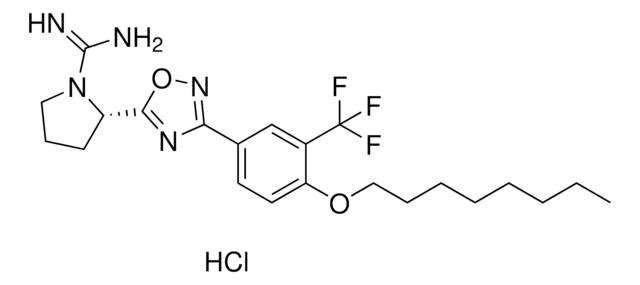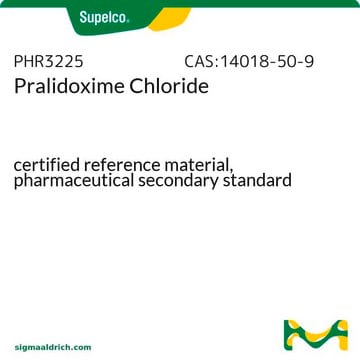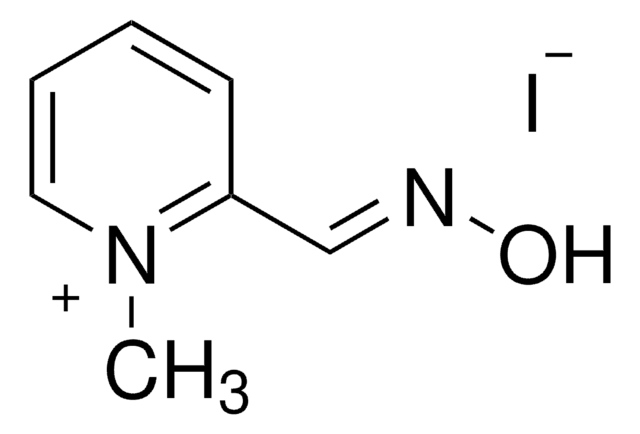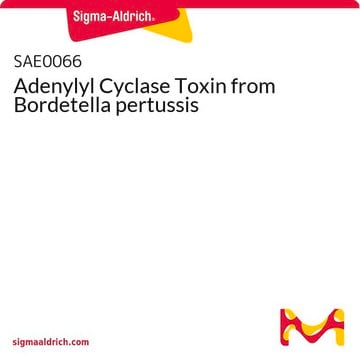SML0224
HI-6
≥98% (HPLC)
동의어(들):
1-[[[4-(Aminocarbonyl)pyridinio]methoxy]methyl]-2-[(hydroxyimino)methyl]-pyridinium chloride, 4-Carbamoyl-1-[[[2-[(hydroxyimino)methyl]pyridinium-1-yl]methoxy]methyl]pyridinium dichloride, Asoxime chloride, HI 6, HI 6 chloride, HJ 6, Transant
로그인조직 및 계약 가격 보기
모든 사진(1)
About This Item
실험식(Hill 표기법):
C14H16N4O3 · 2Cl
CAS Number:
Molecular Weight:
359.21
MDL number:
UNSPSC 코드:
12352200
PubChem Substance ID:
NACRES:
NA.77
추천 제품
분석
≥98% (HPLC)
형태
powder
색상
white to beige
solubility
H2O: 15 mg/mL (clear solution)
배송 상태
wet ice
저장 온도
−20°C
SMILES string
[Cl-].[Cl-].NC(=O)c1cc[n+](COC[n+]2ccccc2\C=N\O)cc1
InChI
1S/C14H14N4O3.2ClH/c15-14(19)12-4-7-17(8-5-12)10-21-11-18-6-2-1-3-13(18)9-16-20;;/h1-9H,10-11H2,(H-,15,19);2*1H
InChI key
QELSIJXWEROXOE-UHFFFAOYSA-N
일반 설명
HI-6 functions as an antidote for treating intoxication caused by nerve agents. It acts as a potent drug in radiation protection and suppresses oxidative stress. HI-6 prevents the toxicity of the antineoplastic drug irinotecan.
생화학적/생리학적 작용
HI-6 is an efficient oxime cholinesterase reactivator that is used as an antidote for organophosphates (Ops) exposure.
Storage Class Code
11 - Combustible Solids
WGK
WGK 3
Flash Point (°F)
Not applicable
Flash Point (°C)
Not applicable
시험 성적서(COA)
제품의 로트/배치 번호를 입력하여 시험 성적서(COA)을 검색하십시오. 로트 및 배치 번호는 제품 라벨에 있는 ‘로트’ 또는 ‘배치’라는 용어 뒤에서 찾을 수 있습니다.
Helen Mumford et al.
Chemico-biological interactions, 203(1), 160-166 (2012-09-18)
Potent organophosphorous (OP) agents, such as VX, are hazardous by absorption through the skin and are resistant to conventional pharmacological antidotal treatments. The residence time of a stoichiometric bioscavenger, human butyrylcholinesterase (huBuChE), in the plasma more closely matches that of
Miroslav Pohanka et al.
Environmental toxicology and pharmacology, 32(1), 75-81 (2011-07-27)
Asoxime (HI-6) is a well known oxime reactivator used for counteracting intoxication by nerve agents. It is able to reactivate acetylcholinesterase (AChE) inhibited even by sarin or soman. The present experiment was aimed to determine markers of oxidative stress represented
C G Rousseaux et al.
Canadian journal of physiology and pharmacology, 67(10), 1183-1189 (1989-10-01)
HI-6 is an oxime experimentally developed for reactivation of previously untreatable soman-phosphorylated acetylcholinesterase. It has been shown to be effective in restoring acetylcholinesterase activity after poisoning with other "nerve agents" namely VX and sarin; however, its antidotal qualities for the
Paul M Lundy et al.
Toxicology, 285(3), 90-96 (2011-04-29)
The oximes pralidoxime (2-PAM), its dimethanesulphonate salt derivative P2S, and obidoxime (toxogonin) are currently licensed and fielded for the treatment of chemical warfare (CW) organophosphorous (OP) nerve agent poisoning. While they are effective against several of the identified threat CW
T Seeger et al.
Toxicology letters, 206(1), 72-76 (2011-08-02)
An important factor for successful therapy of poisoning with organophosphorus compounds (OP) is the rapid restoration of blocked respiratory muscle function. To achieve this goal, oximes are administered for reactivation of inhibited acetylcholinesterase (AChE). Unfortunately, clinically used oximes, e.g. obidoxime
자사의 과학자팀은 생명 과학, 재료 과학, 화학 합성, 크로마토그래피, 분석 및 기타 많은 영역을 포함한 모든 과학 분야에 경험이 있습니다..
고객지원팀으로 연락바랍니다.







